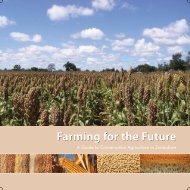Restoring the Soil - Canadian Foodgrains Bank
Restoring the Soil - Canadian Foodgrains Bank
Restoring the Soil - Canadian Foodgrains Bank
You also want an ePaper? Increase the reach of your titles
YUMPU automatically turns print PDFs into web optimized ePapers that Google loves.
Existing Green Manure/Cover Cropping Systems Around The World132. The slow results. <strong>Soil</strong> improvement is a long-term process that may not be immediatelynoticeable to <strong>the</strong> farmer. Usually, significant improvement in productivity doesnot occur until after <strong>the</strong> first crop of gm/cc has been applied to <strong>the</strong> soil, which meansthat concrete, visible results are not apparent until well into <strong>the</strong> second cropping cycle.This slow appearance of results—improved soils—that are often difficult for people tobelieve, fur<strong>the</strong>r complicates <strong>the</strong> adoption of gm/ccs. Once again, it is often preferableto promote gm/ccs for some reason o<strong>the</strong>r than soil fertility. If farmers are not awareof <strong>the</strong> value of organic matter in <strong>the</strong>ir soils, a heavy application of animal manureon a small plot of land <strong>the</strong> first year will help make farmers aware of <strong>the</strong> value of <strong>the</strong>organic matter <strong>the</strong> gm/ccs are producing in <strong>the</strong>ir fields (Photo 7). Simple demonstrations,such as showing how organic matter increases <strong>the</strong> water-holding capacity of soil,can also be used.3. Dry season problems. Often gm/ccs must produce <strong>the</strong>ir organic matter at <strong>the</strong> endof <strong>the</strong> wet season, or must continue to grow during <strong>the</strong> dry season. Grazing animals,wild animals, termites, agricultural burning, bush fires or several o<strong>the</strong>r problems maydestroy organic matter or growing plants before <strong>the</strong> farmer can use <strong>the</strong>m <strong>the</strong> followingrainy season. In very hot climates and on soils with no shade, <strong>the</strong> nitrogen and muchof <strong>the</strong> organic matter will be burned off by <strong>the</strong> tropical sun. Thus, almost no benefitfrom <strong>the</strong> gm/cc will be available for <strong>the</strong> next crop.4. Difficult growing conditions. Smallholder farmers in <strong>the</strong> tropics commonly copewith many challenging conditions, including extremely low or irregular rainfall,extremes in soil pH, severe drainage problems, or a combination of <strong>the</strong>se. Such conditionswill reduce <strong>the</strong> growth of gm/ccs, <strong>the</strong>reby reducing or destroying <strong>the</strong>ir impact.Through <strong>the</strong> years, we have learned how to overcome an increasing number of suchproblems. The solution is often to use gm/cc species that are particularly resistant tocertain problems. For example, jackbean can withstand very poor soils and is oftenused for recuperating wastelands. However, <strong>the</strong>se solutions are often achieved by usinggm/cc species that produce less organic matter, don’t fix as much nitrogen, don’t haveadditional benefits, or don’t fit as well into <strong>the</strong> local farming system.5. Timing (also called “synchronization”). The nutrients provided by <strong>the</strong> gm/ccs,especially nitrogen, must be available to crops when <strong>the</strong>y need <strong>the</strong>m in order to raiseproductivity. Gm/ccs will boost farmers’ productivity only if <strong>the</strong> gm/ccs’ nutrients areavailable to <strong>the</strong> crops at <strong>the</strong> right time. In many gm/cc systems, <strong>the</strong> correct timing isei<strong>the</strong>r impossible or very difficult to achieve. Therefore, <strong>the</strong> efficiency of <strong>the</strong> systems isreduced.Very often, this problem can be solved using natural foliar nutrient sprays at <strong>the</strong>appropriate time of year to supplement soil nutrients. Solutions of cattle urine orcrushed mo<strong>the</strong>r of cacao (Gliricidia sepium) leaves are often used. Very small amountsof chemical fertilizer can have <strong>the</strong> same effect. These remedies can be very useful insupplying nutrients at exactly <strong>the</strong> time <strong>the</strong> crops are likely to run out of <strong>the</strong> nutrientssupplied by gm/ccs.
















